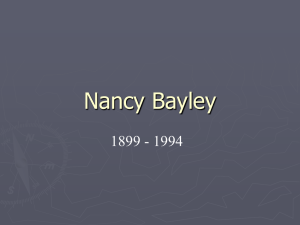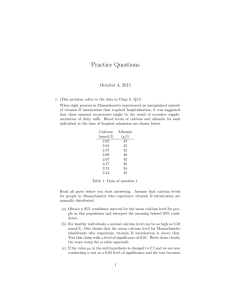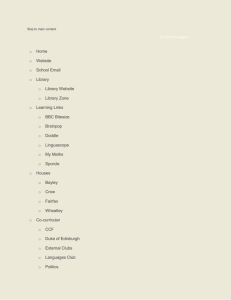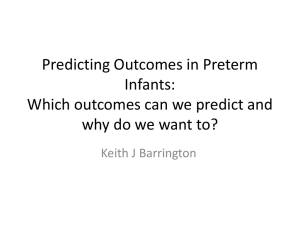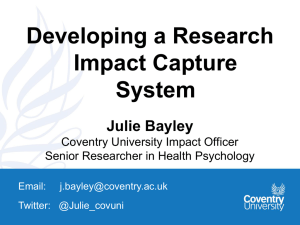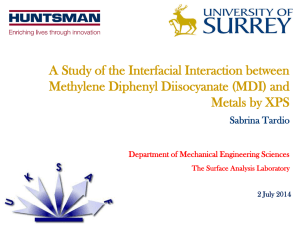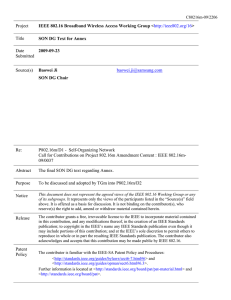Easy (?) as 1,2,3: Issues in Developmental Follow UP of NICU GRADS
advertisement
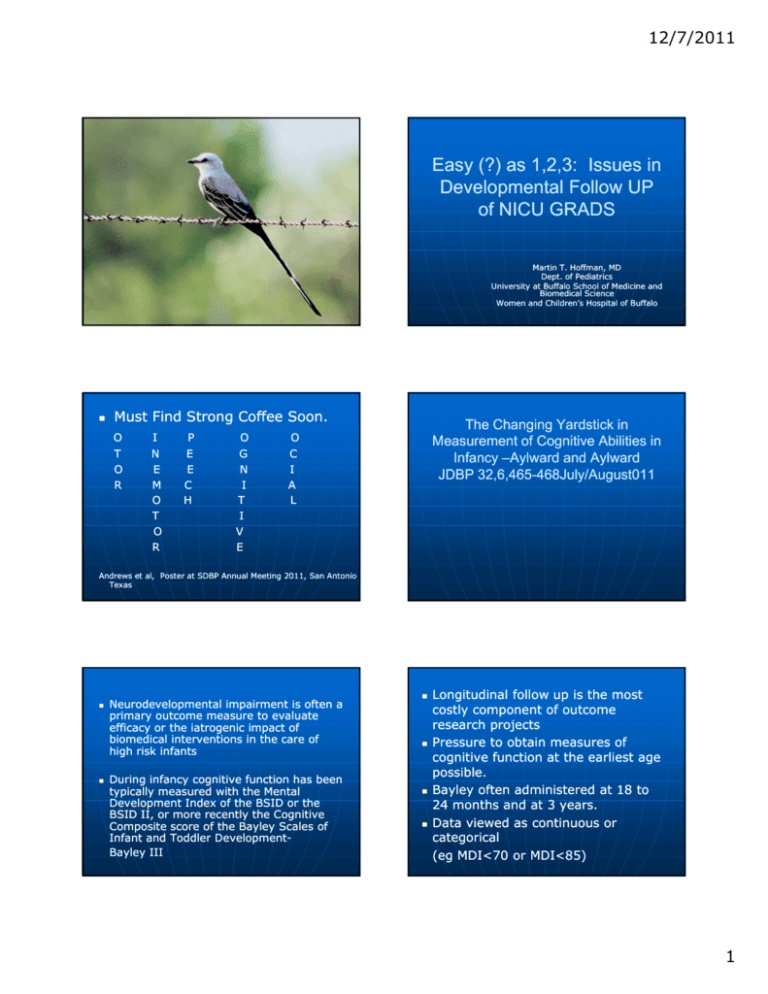
12/7/2011 Easy (?) as 1,2,3: Issues in Developmental Follow UP of NICU GRADS Martin T. Hoffman, MD Dept. of Pediatrics University at Buffalo School of Medicine and Biomedical Science Women and Children’s Hospital of Buffalo Must Find Strong Coffee Soon. O T O R I N E M O T O R P E E C H O G N I T I V E The Changing Yardstick in Measurement of Cognitive Abilities in Infancy –Aylward and Aylward JDBP 32,6,465 32,6,465--468July/August011 O C I A L Andrews et al, Poster at SDBP Annual Meeting 2011, San Antonio Texas Neurodevelopmental impairment is often a primary outcome measure to evaluate efficacy or the iatrogenic impact of biomedical interventions in the care of high risk infants During infancy cognitive function has been typically measured with the Mental Development Index of the BSID or the BSID II, or more recently the Cognitive Composite score of the Bayley Scales of Infant and Toddler Development Development-Bayley III Longitudinal follow up is the most costly component of outcome research projects Pressure to obtain measures of cognitive function at the earliest age possible. possible Bayley often administered at 18 to 24 months and at 3 years. Data viewed as continuous or categorical (eg MDI<70 or MDI<85) 1 12/7/2011 Bayley Scales of Infant Development Bayley scales (BSID) -1969 Bayley Scales II (BSID(BSID-II) – 1993 Direct observational b l scales l standardized tasks • Mental Development Index (MDI) • Psychomotor Development Index (PDI) Flynn Effect Overall mean test scores increase by 0.3 to 0.5 points per year (~5points per decade) ? due to greater cognitive stimulation or increased awareness of tasks in developmental tests or better nutrition (pre and post natal) Flynn, JR What is Intelligence? Beyond the Flynn effect 2007 Normed to give a standard score (mean 100, and SD 15). Bayley III Bayley Scales of Infant and Toddler Development (Bayley(Bayley-III) III)--2006 Introduced the “cognitive composite” (CC) Comparisons • 92 items vs 72 in MDI • Language items not included in CC, moved to separate Language composite And yet, BSID II with Bayley III, comparison in 102 children 11-42 months BSID-II compared to BSID, both BSIDgiven to 200 children 11-42 months MDI was 12 pts t (0.8 (0 8 SD) lower l and d Psychomotor Development Index (PDI) 7 pts lower than on BSID Bayley, The Psychological Corporation 1993 Why? Changes in content, administration and scoring, item gradients, and the floors and ceilings also have an impact and produce more variability Bayley III Cognitive Composite 6 points (0.4 SD) higher than BSIDII MDI Bayley –III PDI 8 points higher. Bayley, Pearson 2006 2 12/7/2011 BSID vs BSID II Mean MDI Scores by Cohort Kids born 19831983-2003 @ < 800g compared in 5 year cohorts. 18 month BSID and BSID II as well as 3 different WPPSI versions. MDI scores 93 93,91, 91 84, 84 85. 85 MDI scores< 70 increased from 7% 14%,/ 18%, 22% PDI scores 89,86/82,78. (despite CP decreasing from 20% to 12%). 94 92 90 88 MDI 86 84 82 80 78 1983-87 1988-92 1993-87 1998 to 03 Synnes et al, J. Peds 2010 BSID--II vs Bayley III BSID Does this represent smaller survivors, changes in referral, changes in medical practices, environmental factors. factors To what extent were results affected by the test? 40 kids mean gest age 26 weeks mean bw 891 gm. All given both evaluations; Robertson etal, Application of the Flynn Effect for the Bayley III Scales; Scales; Arch. Pediatrics and Adolescent Medicine 2010:164:1072--73 2010:164:1072 Compared to what? BSID II MDI mean 89.4, 20% <70 Bayley III CC mean 96.5 0% <70 • For those kids <70 on the BSID II II, Bayley III 23 points higher BSID II MDI correlated more closely with Bayley III Language composite 89.4/88 221 infants <1000g and <28 weeks gestation-- 2year (corrected) 220 controls. gestation Developmental delay decided by comparison t test to t t norms or by b comparison i to t controls t l who took the test. Anderson et al Underestimation of developmental delay by the new Bayley III Arch Pediatr Adolesc Med 2010;164; 332 332--336 3 12/7/2011 Bayley III Cognitive Composite in premies 96.9, (average range) In controls 108.9 Difference was 10 pts when adjusted f maternal for t l education d ti and d family f il structure and 8.9 when add’tl adjustment for CP/deafness. This difference is 2/3 of a standard deviation. Similar results for language composite Vs V norms 45 40 35 30 Vs. Norms Vs. Controls 25 Cognitive 13% Vs controls 33% Percent of Children identified as delayed, comparison to norms vs. Controls. 50 Rates of developmental delay (mild, moderate, severe) for Language 21% 43% Motor 16% 48% M. Msall editorialeditorial- “using the Bayley III will underestimate problems and reduce eligibility for intervention services” services Arch Ped and Adolesc Adolesc. Med 2010 20 15 10 5 0 Cognitive Language Motor Learning Problems in Kindergarten Students with Preterm birth Cohort of 148 kids born between 1/1/2001 and 12/31 2003 <28 weeks gestation,+/or <1000g and 111 classmate controls born at term with normall birth bi th weight. i ht Outcome measures achievement tests, teacher ratings of learning progress, individual educational assistance. Taylor et al Arch Pediatr Adoles Med Sept. 2011:165:8192011:165:819-826 Also, this overestimation will reduce ability to compare to earlier studies with BSID and BSID II. 117 different schools in 57school districts in Cleveland area. Multiple assessments in one setting Achievement deficits noted in spelling and applied math (when a subgroup with neurosensory issues is removed, only deficits are in math). Risk factors ,25 weeks, abnl US of head, BPD, and infection, Neurodevelopmental impairment at 20 months and lower. MANY DID NOT HAVE AN IEP. 4 12/7/2011 Predictive Ability? 200 ELBW infants <1000 g from a cohort born 1992 to 1995 BSID II @ 1818-20 months CA KABC Mental Processing Composite@8 years PE both times Major Neurologic Abn. 19% at 20 mos. And 16% at 8 years. ELBW without Neurosensory Handicap: 20 months MDI 79.3 (16) 8 year MPC 92.3 (16) Classmate control 99.8 (15) ELBW with Neurosensory Handicap 20 month MDI 63.2 (15) 8 year MPC 72.9 (2) Hack et al. Poor Predictive Ability of the BSID for Cognitive Function in ELBW children at School age Pediatrics August 2005 Predictive value Handicap Identified by MDI vs MPC For Neurosenory normal MDI <70 PPV 0.37 (0.27(0.27-0.49) 80 70 60 50 20 month MDI 8 year MPC <70 40 30 For Neurosensory abnormal MDI <70 PPV 0.61 (0.42(0.42-0.77) 20 10 0 <70 <85 <70 Addressing counseling families “Based on our results and those of others, results of the Bayley Scales of Infant Development or similar cognitive assessments should not be used to make decisions about medical treatment or policy, especially those as important as the life and eath of ELBW infants.” “We suggest that the data used for reporting early childhood outcomes of infants born at the limits of viability be based mainly on the rates of children with neurosensory impairment who also have cognitive deficits rather than on cognitive deficits per se” Hack et al. 5 12/7/2011 Recommendations Would their recommendation been any different if they had the Bayley III available? (fewer kids would have had Cognitive Composite <70) Comparison to norms and control groups Be aware of the “noise” that changes in test versions and variability in mean scores adds to the comparisons and further predictions. 6
